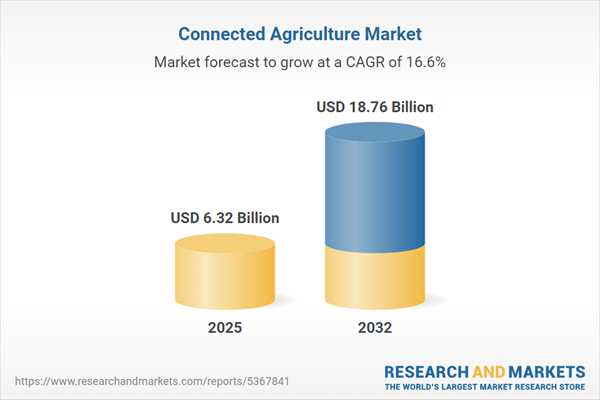Speak directly to the analyst to clarify any post sales queries you may have.
The connected agriculture market is evolving rapidly as digital technologies, data-driven insights, and IoT integration reshape global agricultural value chains. Senior decision-makers now face both opportunity and complexity as innovations accelerate, regulatory environments shift, and new business models gain traction.
Market Snapshot: Connected Agriculture Market Growth and Dynamics
The Connected Agriculture Market grew from USD 5.47 billion in 2024 to USD 6.32 billion in 2025. It is expected to continue growing at a CAGR of 16.64%, reaching USD 18.76 billion by 2032.
Scope & Segmentation of the Connected Agriculture Market
- Component: Consulting Services, Managed Services, Professional Services, Support & Maintenance, Training & Education, Crop Monitoring, Farming Machinery Management, Greenhouse Automation, Irrigation Management, Livestock Monitoring, Weather & Soil Monitoring
- Module: Application Enablement, Connectivity Management, Device Management
- Deployment: Cloud, On-Premises
- Application: In-Production Planning & Management, Post-Production Planning & Management, Pre-Production Planning & Management
- End User: Farmers, Government Agencies, Research Institutions
- Region: Americas (United States, Canada, Mexico, Brazil, Argentina, Chile, Colombia, Peru), Europe, Middle East & Africa (United Kingdom, Germany, France, Russia, Italy, Spain, Netherlands, Sweden, Poland, Switzerland, United Arab Emirates, Saudi Arabia, Qatar, Turkey, Israel, South Africa, Nigeria, Egypt, Kenya), Asia-Pacific (China, India, Japan, Australia, South Korea, Indonesia, Thailand, Malaysia, Singapore, Taiwan)
- Companies Covered: Accenture PLC, Ag Leader Technology, AGCO Corporation, AGRIVI Ltd., BASF SE, Bayer AG, Cisco Systems, Inc., CNH Industrial N.V., Conservis By Traction Ag Inc., Corteva, Inc., Cropin Technology Solutions Private Limited, Croptracker, Inc., Deere & Company, Farmers Edge Inc., Gamaya, Granular Inc., Hexagon AB, International Business Machines Corporation, Kubota Corporation, Lindsay Corporation, Microsoft Corporation, Oracle Corporation, Robert Bosch GmbH, SAP SE, Shivrai Technologies Pvt. Ltd., SMAG by InVivo, Syngenta AG, Taranis, TELUS Communications Inc., Tend.com, Topcon Corporation, Yara International ASA
Key Takeaways for Senior Decision-Makers
- IoT, machine learning, and cloud platforms are promoting granular, data-driven decision support from crop monitoring to supply chain transparency.
- Innovative service models, including predictive analytics and remote monitoring, are opening new revenue and partnership opportunities across the value chain.
- Regional variations shape adoption: North America leads with strong investments, Europe focuses on sustainability, the Middle East deploys solutions for water management, and Asia-Pacific adapts technologies for smallholder farms.
- Collaborations between equipment manufacturers and technology firms are accelerating platform interoperability and vertical integration.
- Emergent companies are leveraging AI, robotics, and blockchain to disrupt traditional workflows and establish modular, scalable platforms.
- Service-oriented strategies, including bundled hardware and ongoing support, are reducing adoption barriers for smaller farms and enhancing user retention.
Assessing Tariff Impact and Supply Chain Reconfiguration
Recent trade tariffs have prompted equipment and service providers to diversify sourcing, adjust manufacturing strategies, and explore joint ventures. These shifts have introduced cost pressures for advanced equipment and components, particularly in precision agriculture. Subscription models and partnership-driven relief programs are helping stakeholders manage input volatility while maintaining access to crucial digital infrastructure.
Methodology & Data Sources
The research utilized a robust mixed-methods approach to deliver actionable insights for the connected agriculture market. Primary interviews engaged senior executives in manufacturing, technology development, and policymaking. Secondary analysis incorporated industry reports, patents, academic studies, and public datasets, ensuring triangulation and data integrity through scenario-based validation and segmentation matrices.
Why This Report Matters
- Identifies actionable strategies for technology investment, operational efficiency, and partnership building across regional and industry segments.
- Delivers a clear assessment of emerging threats and opportunities driven by regulation, technology shifts, and evolving business models.
- Supports benchmarking and competitive analysis for senior leaders navigating the rapidly changing connected agriculture landscape.
Conclusion
As connectivity and analytics transform agriculture, industry leaders positioned for agile adaptation, platform integration, and collaborative innovation will unlock the sector’s next wave of value creation and operational efficiency.
Additional Product Information:
- Purchase of this report includes 1 year online access with quarterly updates.
- This report can be updated on request. Please contact our Customer Experience team using the Ask a Question widget on our website.
Table of Contents
3. Executive Summary
4. Market Overview
7. Cumulative Impact of Artificial Intelligence 2025
Companies Mentioned
The companies profiled in this Connected Agriculture market report include:- Accenture PLC
- Ag Leader Technology
- AGCO Corporation
- AGRIVI Ltd.
- BASF SE
- Bayer AG
- Cisco Systems, Inc.
- CNH Industrial N.V.
- Conservis By Traction Ag Inc.
- Corteva, Inc.
- Cropin Technology Solutions Private Limited
- Croptracker, Inc.
- Deere & Company
- Farmers Edge Inc.
- Gamaya
- Granular Inc.
- Hexagon AB
- International Business Machines Corporation
- Kubota Corporation
- Lindsay Corporation
- Microsoft Corporation
- Oracle Corporation
- Robert Bosch GmbH
- SAP SE
- Shivrai Technologies Pvt. Ltd.
- SMAG by InVivo
- Syngenta AG
- Taranis
- TELUS Communications Inc.
- Tend.com
- Topcon Corporation
- Yara International ASA
Table Information
| Report Attribute | Details |
|---|---|
| No. of Pages | 189 |
| Published | November 2025 |
| Forecast Period | 2025 - 2032 |
| Estimated Market Value ( USD | $ 6.32 Billion |
| Forecasted Market Value ( USD | $ 18.76 Billion |
| Compound Annual Growth Rate | 16.6% |
| Regions Covered | Global |
| No. of Companies Mentioned | 33 |









